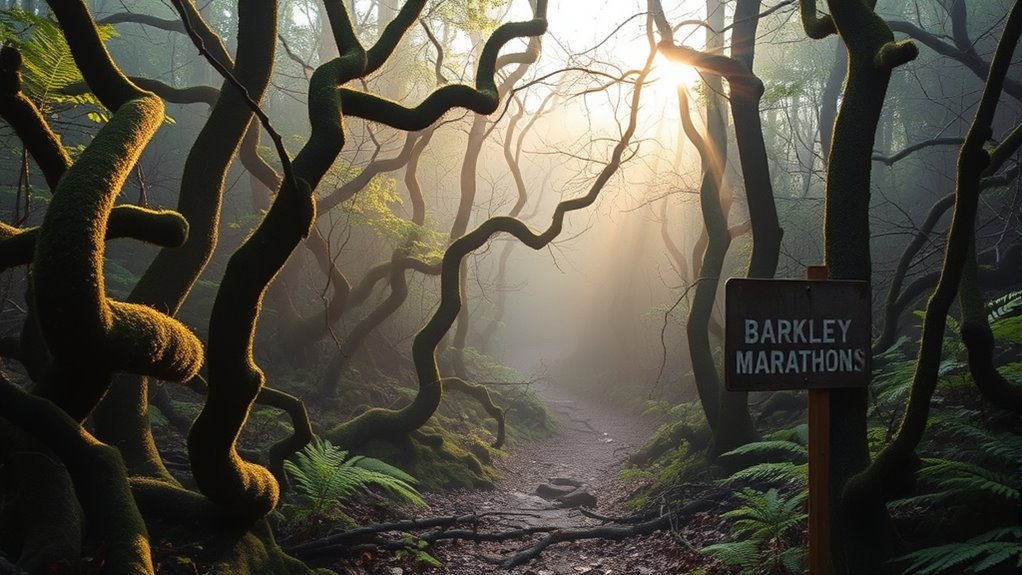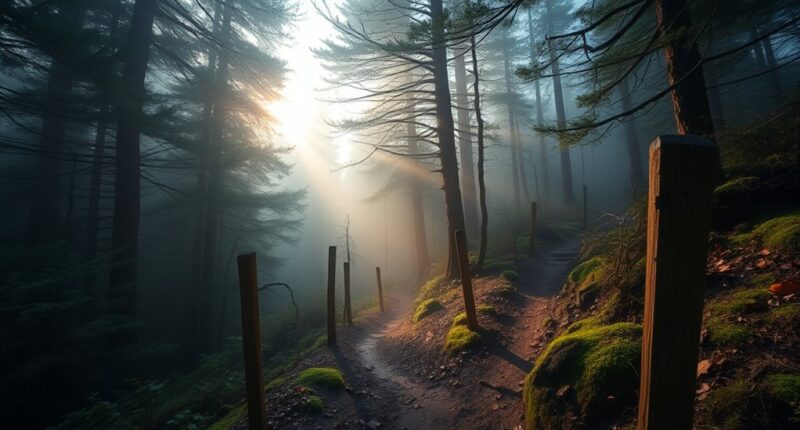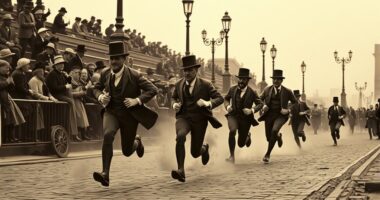The Barkley Marathons originated in the early 1980s when Gary “Lazarus Lake” Cantrell created it as a test of mental and physical endurance. The race’s origins are shrouded in mystery and legend, with stories blending fact and folklore that add to its mystique. Known for its extreme difficulty and unique format, the race pushes participants to their limits, emphasizing resilience and ingenuity. Keep exploring to uncover the secrets behind this legendary race’s enduring fascination.
Key Takeaways
- The Barkley Marathons’ origins are surrounded by legend, created by Gary Cantrell to challenge elite endurance athletes.
- The race’s name and mystique are linked to the nearby town of Barkley, Tennessee, and local lore.
- It started in 1986 as a response to traditional ultramarathons, emphasizing mental toughness and unconventional challenges.
- The race features unique traditions, such as participants retrieving a license plate from a specific tree.
- Its lore is built on the difficulty, secrecy, and the legendary status of few finishers.

The Barkley Marathons is one of the most challenging and mysterious ultramarathons in the world, pushing runners to their physical and mental limits. Its reputation stems from the extreme trail difficulty and the demanding preparation required to even consider participating. You’ll find that this race isn’t just about speed; it’s about endurance, resilience, and strategic thinking. The course itself is a rugged, unforgiving wilderness that covers roughly 100 miles of dense forest, steep hills, and rocky terrain. Charting it demands more than just stamina—it requires a deep understanding of the trail, quick decision-making, and the ability to adapt on the fly. The trail difficulty is compounded by unpredictable weather, fallen trees, and the rugged terrain, which often forces runners to scramble, crawl, or climb. If you’re serious about running the Barkley, your preparation must go beyond typical training. You’ll need to focus on building your strength, endurance, and mental toughness, as well as mastering navigation skills. Many participants spend months training specifically for this race, incorporating trail running on similar terrain, practicing map reading, and simulating the race’s unpredictable conditions. Preparation also involves understanding your own limits and developing strategies to conserve energy during the grueling laps. Unlike traditional races, the Barkley doesn’t have aid stations or support crews—you’re on your own, which means you must be self-sufficient and resourceful. You’ll need to carry essentials, manage your nutrition, and stay mentally focused through hours of solitude and physical pain. The race’s unique entry process further emphasizes its mystique. You usually submit an essay and pay a small fee, but gaining entry is a challenge in itself. Only a handful of runners are accepted each year, and many don’t finish the race at all. The race’s origins are shrouded in legend, but what remains consistent is its reputation as a true test of human endurance. If you plan to take on the Barkley, you’ll realize that the trail difficulty is only part of the challenge. The real test is your ability to prepare thoroughly, adapt to chaos, and keep pushing forward when everything seems against you. Success depends on meticulous planning, relentless training, and a resilient mindset. Additionally, participating in remote hackathons can develop problem-solving skills and adaptability that are valuable in extreme endurance events. It’s a race that separates those who are merely fit from those who are truly prepared to confront the wilderness and their own limits.
Frequently Asked Questions
What Is the Maximum Time Allowed to Complete the Race?
You have 60 hours to complete the Barkley Marathons, which is the race duration and the set time limit for finishing. During this challenging race, you must navigate through rugged terrain, often pushing your limits to stay within this strict timeframe. If you don’t finish within 60 hours, you’re disqualified. This intense time constraint tests your endurance, navigation skills, and mental toughness throughout the grueling course.
How Many Participants Typically Attempt the Barkley Marathons Each Year?
You usually see around 40 to 60 brave souls attempting the Barkley Marathons each year. Despite tough entry criteria and a diverse participant demographic, only a handful make it to the finish line. It’s a real shot in the dark, as most drop out early. The challenge attracts seasoned ultrarunners and adventure seekers alike, all enthusiastic to test their limits in this legendary race where grit and determination are key.
What Are the Specific Entry Requirements and Selection Process?
To enter the Barkley Marathons, you need to meet specific entry criteria, such as submitting a creative book or essay and paying a registration fee. The selection process is informal but competitive; organizers review your submission and choose participants based on originality and dedication. Only a limited number of runners are accepted each year, making the entry process highly selective. Be prepared to demonstrate your passion and commitment to the challenge.
Are There Any Safety Measures or Support Teams During the Race?
Imagine you’re running the Barkley Marathons, and safety measures are vital. Race organizers prioritize your safety with support teams stationed along the course, ready to assist if needed. Supporter roles include providing aid, navigation help, and communication with race officials. While the race emphasizes self-reliance, safety protocols guarantee you’re protected during this grueling challenge, blending old-school adventure with modern race safety standards.
How Has the Race Evolved Since Its Inception in 1986?
Since 1986, the Barkley Marathons has evolved considerably, attracting more diverse participant demographics and setting new race records. You’ll notice the race becoming more competitive, with fewer finishers and faster times, as runners push their limits. The organizers have also refined the course and rules, increasing its difficulty. Despite these changes, the race maintains its mystique, challenging even the most experienced ultra-distance athletes worldwide.
Conclusion
As you stand at the edge of the forest, remember the legend of the Barkley Marathons—an unyielding test of will, like climbing the Mount of the Gods. Its mysterious origins whisper tales of obsession and resilience, echoing through the silent trees. This race isn’t just about crossing finish lines; it’s about confronting your inner demons, much like a hero facing their darkest night. Embrace the challenge, and maybe, just maybe, you’ll find your own myth within the woods.









